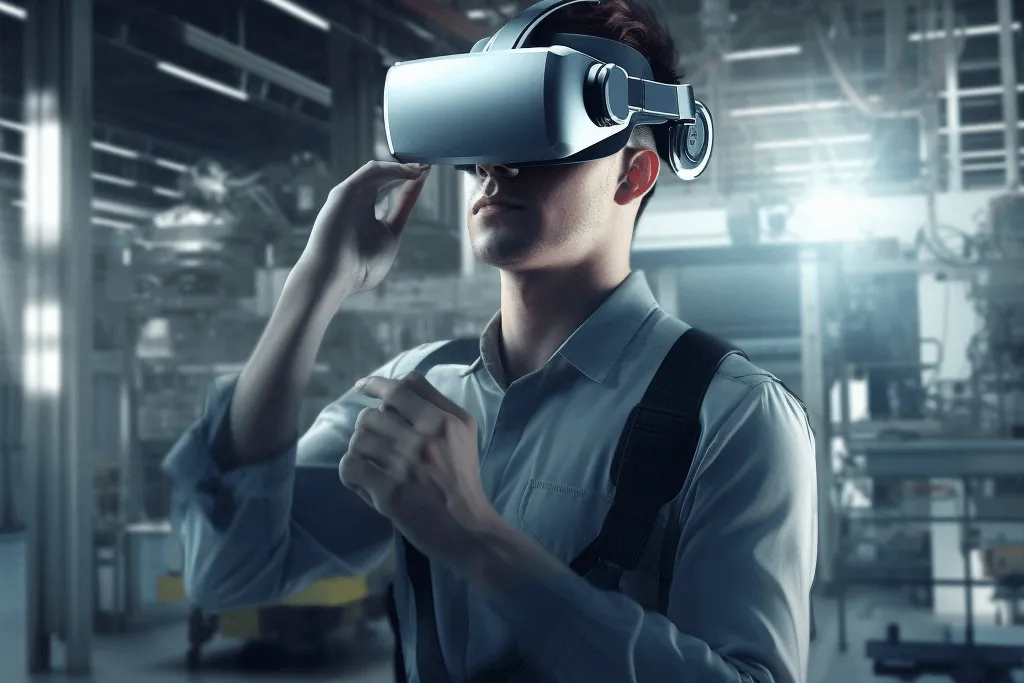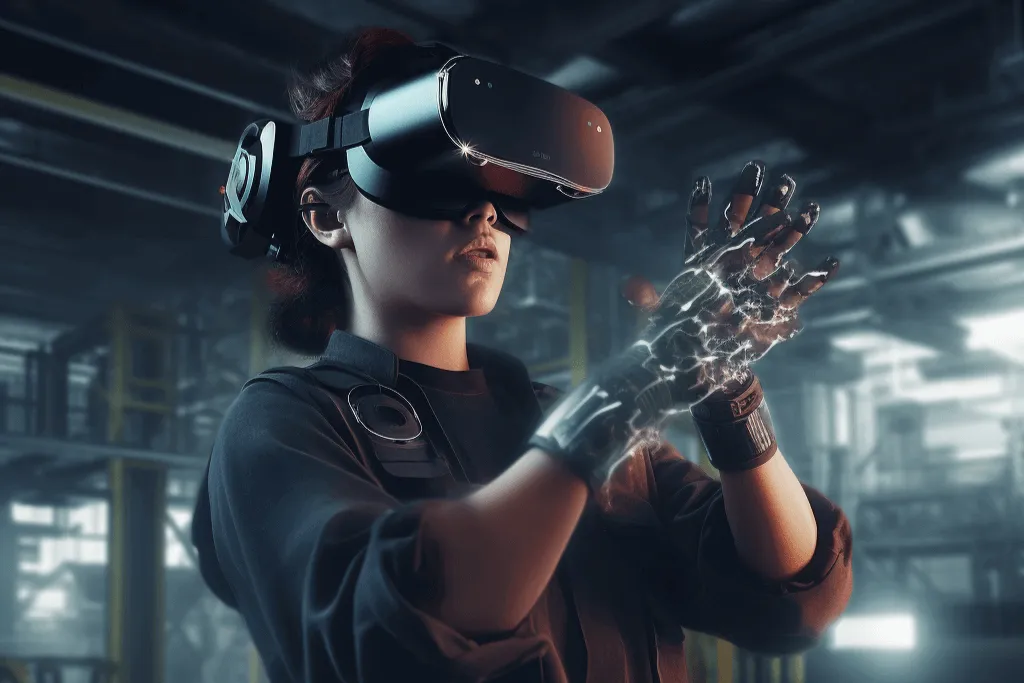Virtual reality (VR) is rapidly transforming the manufacturing industry by offering innovative solutions for product design, employee training, and process optimization. As industries become more complex and competitive, the adoption of VR provides a powerful tool to enhance productivity, reduce costs, and accelerate the manufacturing process. This article delves into how VR is being used in manufacturing, exploring its various applications and benefits. Whether you’re a manufacturer considering the adoption of VR or simply interested in cutting-edge technologies, this article will provide valuable insights into the future of manufacturing.
What is Virtual Reality in Manufacturing Industry?
Virtual reality in manufacturing refers to the application of VR technologies within the manufacturing industry to create immersive and interactive virtual environments that can be used for a variety of purposes. These virtual environments allow manufacturers to simulate, design, and optimize manufacturing processes in a controlled and risk-free setting. By integrating VR into their operations, manufacturing companies can improve efficiency, reduce costs, and enhance product development.
The use of VirtualReality in manufacturing is becoming increasingly common as the technology evolves, offering more sophisticated and accessible solutions. The ability to create virtual prototypes, simulate assembly lines, and train employees in a virtual environment is revolutionizing the way the manufacturing industry operates.
Why is VR Important for the Manufacturing Industry?
The manufacturing industry is under constant pressure to innovate and improve productivity while reducing costs and time to market. VR technology offers a unique solution to these challenges by providing a platform for virtual prototyping, training, and process optimization.
One of the key reasons VR is important for the manufacturing industry is its ability to reduce the time and costs associated with product development. By using virtual prototypes, manufacturers can test and refine designs before committing to physical production, minimizing the risk of costly errors. Additionally, VR allows for the simulation of manufacturing processes, enabling companies to identify potential bottlenecks and inefficiencies before they occur in the real world.
Furthermore, VR training provides a safe and effective way to train employees on complex machinery and procedures. This not only improves safety but also reduces the learning curve for new workers, leading to higher productivity and lower training costs.
How is VR Used in Manufacturing?
VR for manufacturing is used in a variety of ways, each offering distinct benefits. The most common applications of VR in the manufacturing industry include product design, process optimization, and employee training.
Manufacturers use VR to create virtual models and prototypes, allowing them to visualize and test products in a virtual environment before moving to physical production. This approach not only saves time and resources but also enables more iterative and flexible design processes.
In terms of process optimization, VR allows manufacturers to simulate assembly lines and production processes in a virtual environment. By identifying inefficiencies and testing different configurations, manufacturers can optimize their operations without disrupting actual production.
Finally, VR training is increasingly being used to train employees on machinery and safety procedures. By creating a virtual reality training program, companies can ensure that their workers are well-prepared to handle the demands of the manufacturing environment.
VR for Product Design and Prototyping
One of the most significant uses of VR in the manufacturing industry is in product design and prototyping. VR technology allows designers and engineers to create detailed virtual prototypes, which can be tested and modified in a virtual environment before any physical prototypes are built. This approach offers several advantages.
Firstly, using virtual prototypes significantly reduces the time and costs associated with the traditional prototyping process. Instead of creating multiple physical prototypes, which can be expensive and time-consuming, designers can iterate on virtual models quickly and efficiently. This allows for more experimentation and innovation in the design process.
Secondly, VR for product design enables better collaboration among teams. Designers, engineers, and other stakeholders can interact with virtual models in real-time, making it easier to share ideas and feedback. This collaborative approach can lead to more innovative designs and a smoother product development process.

Finally, VR allows for the creation of highly detailed and accurate virtual replicas of products, which can be used for marketing, training, and customer demonstrations. This not only enhances the overall product development process but also adds value across the manufacturing business.
Using VR in Manufacturing Industry Process Optimization
Optimizing manufacturing processes is a key challenge in the industry, and VR provides a powerful tool to achieve this. By using virtual reality technology, manufacturers can simulate and analyze their production lines in a virtual environment, identifying inefficiencies and areas for improvement.
VR allows manufacturers to simulate assembly lines and other manufacturing processes in a controlled virtual environment. This enables them to experiment with different configurations and workflows without the risk of disrupting actual production. For example, manufacturers can test new equipment layouts, assembly line configurations, and production schedules to determine the most efficient setup.
Moreover, the use of VR for process optimization can lead to significant cost and time savings. By identifying and addressing potential issues in the virtual world, manufacturers can avoid costly mistakes and downtime in the real world. This proactive approach to process optimization is becoming increasingly important as manufacturing systems become more complex and competitive.
Integrating VR into the process optimization efforts of a manufacturing company can lead to improvements in productivity, efficiency, and overall operational effectiveness.
VR Training: Revolutionizing Employee Training and Safety
Employee training is a critical aspect of the manufacturing industry, and VR is revolutionizing how companies approach this task. VR training provides a safe and controlled virtual environment where employees can learn how to operate machinery, follow safety protocols, and handle emergency situations without the risks associated with real-world training.
One of the main benefits of VR training is its ability to simulate real-world scenarios in a way that is both immersive and interactive. Employees can work in a virtual environment that closely mimics their actual work environment, allowing them to gain hands-on experience without the risks. This is particularly valuable for training on complex or dangerous machinery, where mistakes can be costly or even deadly.
Additionally, VR training allows for more personalized and flexible training programs. Employees can learn at their own pace, repeating exercises as needed to master specific skills. This not only improves the effectiveness of the training but also reduces the time and costs associated with traditional training methods.
Overall, the use of VR training in the manufacturing industry is a game-changer, offering a safer, more efficient, and more effective way to train employees.
Real-World Use Cases of VR in Manufacturing
There are numerous real-world examples of how VR is being used in the manufacturing industry to drive innovation and improve efficiency. From automotive giants to electronics manufacturers, companies across various sectors are leveraging VR technology to gain a competitive edge.
In the automotive industry, for example, VR is being used to design and test new vehicles before they are built. Companies like Ford and Volkswagen employ VR to create virtual prototypes of their vehicles, allowing designers and engineers to collaborate on designs and make adjustments in real-time. This not only speeds up the design process but also ensures that the final product meets the highest standards of quality and safety.
Similarly, electronics manufacturers are using VR to optimize their assembly lines and production processes. By simulating the manufacturing process in a virtual environment, companies can identify inefficiencies and make data-driven decisions to improve productivity.
These real-world use cases demonstrate the potential for virtual reality to transform the manufacturing industry. As the technology continues to evolve, we can expect to see even more innovative applications of VirtualReality in manufacturing.

Challenges and Limitations of Implementing VR in Manufacturing
While the benefits of VirtualReality in manufacturing are clear, there are also several challenges and limitations to consider when implementing this technology. Understanding these challenges is crucial for manufacturers looking to adopt VR and integrate it into their operations.
One of the main challenges is the cost of VR equipment and software. Although the price of VR headsets and related technology has decreased in recent years, it can still be a significant investment for manufacturing companies, especially smaller businesses. Additionally, the cost of developing custom VR applications and integrating them with existing manufacturing systems can be substantial.
Another limitation is the need for specialized skills and knowledge to use VR effectively. Manufacturing companies may need to invest in training for their employees or hire VR specialists to develop and maintain their VR systems. This can be a barrier to adoption for some companies, particularly those with limited resources.
Finally, there are technical limitations to consider. While VR technology has advanced rapidly, there are still challenges related to the resolution, latency, and realism of VR environments. These technical limitations can impact the effectiveness of VR applications, particularly in scenarios that require high levels of detail and precision.
Despite these challenges, the potential benefits of VR in manufacturing make it a worthwhile investment for many companies. By carefully considering these challenges and planning accordingly, manufacturers can successfully implement VR and reap its rewards.
The Future of VR in the Manufacturing Industry
The future of VR in the manufacturing industry looks promising, with continued advancements in technology and increasing adoption across the sector. As VR technology becomes more accessible and affordable, we can expect to see even more innovative applications of VR in manufacturing.
One area where VR is likely to have a significant impact is in the integration with other emerging technologies, such as the Internet of Things (IoT) and artificial intelligence (AI). By combining VR with these technologies, manufacturers can create even more sophisticated and intelligent manufacturing systems that are capable of optimizing processes in real-time.
Additionally, the future of VirtualReality in manufacturing may include more widespread use of augmented reality (AR) and mixed reality (MR) technologies. These technologies offer new possibilities for enhancing the manufacturing process, from providing real-time data overlays to enabling remote collaboration between teams.
Ultimately, the adoption of VR in the manufacturing industry is likely to continue growing as companies recognize the benefits of this technology. As VR becomes more ingrained in the manufacturing process, it will play a crucial role in driving innovation, improving efficiency, and maintaining competitiveness in an increasingly challenging market.
Summary: Key Takeaways on VR in Manufacturing
- VirtualReality in manufacturing is transforming the industry by offering innovative solutions for product design, process optimization, and employee training.
- The manufacturing industry benefits from VR through reduced costs, improved productivity, and enhanced product development processes.
- VR is used in manufacturing for creating virtual prototypes, simulating assembly lines, and providing immersive training experiences.
- VR training is revolutionizing employee training by offering safe and controlled virtual environments for learning and skill development.
- Real-world use cases of VirtualReality in manufacturing demonstrate the potential of this technology to drive innovation and efficiency.
- Challenges such as cost, technical limitations, and the need for specialized skills must be considered when implementing VR in manufacturing.
- The future of VR in manufacturing is bright, with potential advancements in integration with IoT, AI, AR, and MR technologies.
By leveraging the power of VR, the manufacturing industry can continue to evolve and thrive in an increasingly competitive and technologically advanced landscape.
My name is Jason, and I'm passionate about the latest technologies, especially VR 🎮, AR 🌐, and XR 🚀. I love exploring how these exciting advancements can be used in different areas of life to make everyday experiences better.


